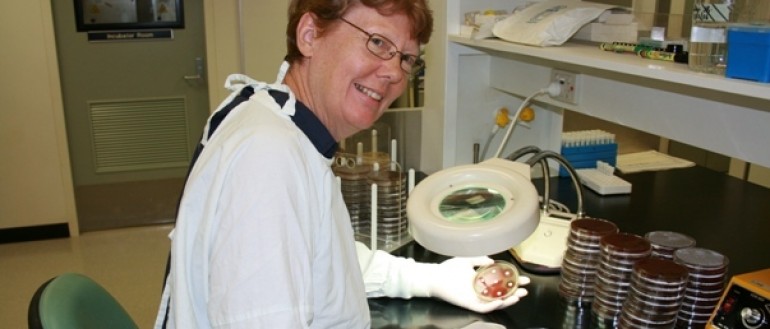Menzies’ Senior Research Officer Kim Hare was recently awarded a Peter Doherty Australian Biomedical Fellowship as part of the National Health and Medical Research Council’s yearly multi-million dollar funding round.
The fellowship provides support for Kim’s salary for the next four years.
Kim shared her thoughts on the new funding.
What is the title of your project fellowship?
Effects of antibiotics, vaccines and environment on the population biology of bacterial respiratory pathogens in Australian Indigenous children – a synthesis of studies.
What major health issue does your research hope to address and how?
Middle ear disease (otitis media) and lower respiratory infections such as pneumonia, bronchiolitis and bronchiectasis remain major health problems affecting Northern Territory Indigenous children.
These conditions not only impact on child health, but lead to poor outcomes in adults.
Many children suffer permanent hearing loss which negatively affects their education and life outcomes.
In addition, severe and recurrent lung infections in childhood can result in chronic suppurative lung disease, which is prevalent in Indigenous children and can lead to early death in adulthood.
My proposal is to combine results from a large body of research conducted at Menzies over the past 20 years to further inform diagnosis, prevention and treatment options for Indigenous children with otitis media and/or lower respiratory infections.
What is the most exciting aspect of your funding win?
This research will add value to the original studies which were undertaken at considerable expense and involved an enormous amount of work.
Although the primary outcomes of these studies have been (or are being) published, much additional valuable information remains to be discovered.
The funding provided will enable further analysis and provide the opportunity to examine interactions between antibiotics, vaccines and the environment, which is generally not possible in individual studies.
We have already published work combining data from five original studies and four follow-up studies to show that respiratory bacterial pathogens from specimens in long-term ultra-freeze storage at Menzies remain viable for at least 12 years. This means that further studies which rely on the long-term viability of these organisms can be undertaken.
The specimens stored at Menzies represent a treasure trove of data. We are in a unique position nationally and globally because we have access to this data from Indigenous Australians who have participated in Menzies research over two decades. This fellowship means that the contributions made by researchers and participants in the past can continue to add to knowledge of ear and lung disease in the Northern Territory.
What are the proposed details of your research methodology (sample numbers, sites etc)?
Standard collection, transport, storage and laboratory methods have been used for all these studies, enabling valid comparisons between studies.
Many hundreds of children throughout the Northern Territory have been involved over the years and thousands of specimens collected.
My research will combine data already stored in Menzies databases relating to the effects of vaccines and antibiotics on respiratory bacteria, including antibiotic resistance.
Environmental factors such as season and climate (comparing the Top End of the Northern Territory to Central Australia) will also be investigated using a range of statistical methods.
What are the broader health implications of your fellowship?
Results from this research will further inform diagnosis, prevention and treatment options for Indigenous children with otitis media and/or lower respiratory infections.
This proposal therefore has the potential to uncover new knowledge which may inform strategies that improve the health of Indigenous Australians.
What are the timeframes for your project and any other major milestone dates?
Below is the proposed four year timeline for the fellowship:
2014: Further statistical and database training; systematic review of the use of the antibiotic azithromycin and its resistance.
2014-15: Analysis of the impact of azithromycin on upper airway carriage (prevalence and density) of bacterial pathogens, and clinical outcomes.
2016: Analysis of vaccine impact on upper airway carriage in healthy children and children with respiratory disease, and clinical outcomes.
2017: Investigation of seasonal, long-term and climatic effects on bacterial carriage.
For more information on this area of work please click here.

